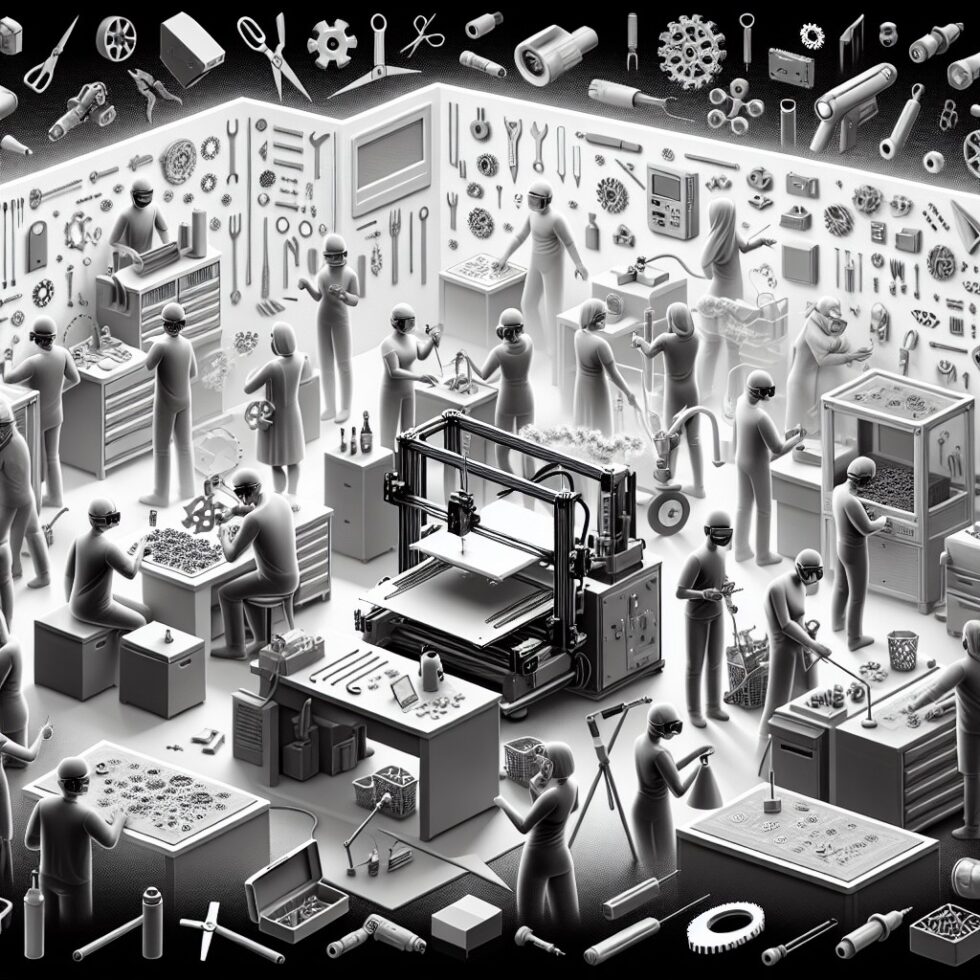
Why Desktop Fabrication Is Having a Moment
The cost to prototype, customize, and build physical things at home has fallen dramatically. Compact FFF 3D printers make brackets and enclosures by the dozen. Resin printers deliver detail you once needed a service bureau to achieve. Affordable laser cutters produce clean, consistent joins in wood, leather, and acrylic. Desktop CNC routers carve precise parts from plywood and aluminum. Together, they form a small, capable “desktop factory”—a set of tools that can turn ideas into objects in a weekend.
This article is a practical guide to build that factory at home. You’ll learn which machines do what, how to plan a safe workspace, how to choose materials, and how to craft a digital workflow that minimizes waste and rework. We’ll also outline costs, maintenance, and habits that turn a hobby into reliable output you can use—or even sell.
The Core Tools: What Each Does Best
FFF 3D Printers (Fused Filament Fabrication)
FFF printers extrude melted plastic filament in layers. They excel at brackets, enclosures, jigs, organizers, cosplay parts, and ergonomic handles. They’re the most forgiving way to prototype quickly, and they handle complex internal shapes that are hard to machine.
- Common materials: PLA for easy prints, PETG for weather resistance, ABS/ASA for heat and toughness, TPU for flexible parts.
- Key features to look for: Direct-drive extruder if you plan to print flexible materials, heated bed for adhesion, automatic bed leveling for reliability, enclosure for ABS/ASA.
- Notes: Printing releases ultrafine particles and VOCs, though levels vary by material. Use good ventilation and filter air when possible.
Resin 3D Printers (SLA/MSLA)
Resin printers use light to cure liquid resin in fine layers. They’re ideal for miniatures, dental models, jewelry masters, tiny clips and gears, and anything that needs crisp edges and a smooth finish.
- Strengths: Very high detail and smooth surfaces with minimal post-processing for visible faces.
- Trade-offs: Resins are chemically hazardous when uncured. You need gloves, eye protection, ventilation, and a dedicated wash and cure setup.
- Notes: Some “tough” and “flexible” resins improve impact resistance but still behave differently than molded plastics. Test before functional use.
Laser Cutters and Engravers
Laser systems cut and engrave sheet materials with precision. Diode lasers are compact, affordable, and best at engraving and cutting thin, dark materials. CO₂ lasers cut acrylic, wood, leather, paperboard, and some rubbers with cleaner edges and faster speeds.
- Best for: Boxes, organizers, signage, stencils, gaskets, leather goods, inlays, custom packaging, and engraving on coated metals.
- Safety: Lasers can start fires. Enclosures, interlocks, and active ventilation are essential. Never cut PVC (toxic chlorine gas) or unknown plastics. Check materials lists carefully.
- Design tip: Kerf (the width of material removed) matters. Design press-fit joints and finger joints with kerf in mind to get snug fits without glue.
Desktop CNC Routers
Routers remove material from a workpiece using rotating cutting tools. They’re excellent for strong parts in wood and aluminum, and for fixtures where stiffness and precision are important.
- Best for: Cutting boards, furniture joints, structural plates, mold patterns, fixtures, and custom panels.
- Key skills: Workholding (clamps, double-sided tape, vacuum), feeds and speeds, toolpaths, and safe chip evacuation.
- Notes: CNC is louder and messier than 3D printing. Use dust collection and hearing protection. Learn to “tram” your spindle to get flat surfaces without ridges.
Safety First: Habits That Keep You Making
Desktop fabrication involves heat, light, chemicals, dust, and mechanical forces. A few disciplined habits make it predictable and safe:
- Ventilation: Place printers and lasers near an exhaust to the outside. Use sealed ducts and backdraft dampers. If you can’t vent outside, use high-quality filter boxes and keep exposure time low.
- PPE: Wear nitrile gloves and safety glasses when handling resin and solvents. Use hearing protection for CNC and lasers. Consider a respirator rated for organic vapors when working with resins or strong-smelling materials.
- Fire readiness: Never leave lasers unattended. Keep a CO₂ or dry chemical extinguisher nearby. Install a visible Emergency Stop button for CNC and laser systems.
- Dust control: Use a shop vac or dust collector with a HEPA filter on CNC. Vacuum after every cut. Wood dust can be hazardous—control it at the source.
- Handling resin waste: Cure contaminated paper towels and failed prints under UV, then dispose as solid waste per local rules. Uncured resin and solvent need household hazardous waste handling.
- Material safety: Read the Safety Data Sheet (SDS) for any resin, solvent, or adhesive. Some woods (e.g., walnut) can cause allergic reactions; some rubbers produce harmful fumes.
- Electrical and placement: Use grounded outlets. Keep liquids away from power supplies. Avoid daisy-chained power strips for high-load tools.
Materials That Behave: A Practical Guide
Filaments
- PLA: Easy, stiff, and dimensionally stable. Not heat-resistant. Great for fixtures, enclosures, and low-stress parts.
- PETG: Slightly flexible, tough, and better with moisture and UV. Good for outdoor items and snap fits.
- ABS/ASA: Higher heat resistance and toughness. Needs enclosure to avoid cracking. ASA resists UV better outdoors.
- TPU/TPE: Flexible and durable. Slower to print but perfect for gaskets, bumpers, and grips.
Resins
- Standard: Great surface finish and detail. Brittle; avoid high-impact use.
- Tough/ABS-like: More resilient; good for snaps and enclosures with careful design.
- Flexible/Elastic: For seals and cushioning. Often need precise exposure settings.
- Specialty: High-temp, castable, dental—designed for very specific workflows.
Laser Materials
- Acrylic (cast): Clean edges, bonds well with solvent cement. Preferred for display cases and light guides.
- Birch plywood: Stable, consistent, finishes well. Choose laser-grade to avoid voids.
- Leather: Genuine leather engraves well; avoid PVC-coated faux leathers.
- Paperboard: Fast and cheap for mockups, packaging inserts, and stencils.
Avoid: PVC, polycarbonate (often chars and clouds), unknown plastics, and anything that smells corrosive when test-engraved.
CNC Stock
- Hardwoods (maple, oak, walnut): Strong and beautiful; seal and finish to protect.
- Plywood (Baltic birch): Stable and great for furniture and fixtures.
- HDPE and acetal: Machine beautifully for jigs and wear parts. Avoid melting by keeping chips thick.
- Aluminum (6061/5052): Possible on hobby routers with conservative parameters and sharp tooling.
Digital Workflow That Saves Time
Mistakes in digital prep cause most wasted material. A simple, repeatable workflow reduces errors and improves finish.
Pick Your Design Tools
- Parametric CAD: Fusion 360, FreeCAD, or Onshape. Great for parts with precise dimensions and assemblies. Design by dimensions and constraints, not just shapes, so you can change one number to update the model.
- Mesh modeling: Blender for organic shapes and figurines; ideal for resin printing.
- Vector 2D: Inkscape or Illustrator for laser work. Keep shapes closed. Name layers by operation (Engrave, Score, Cut) for clarity.
Prep for Each Tool
- FFF slicing: Use PrusaSlicer, Cura, or Bambu Studio. Add chamfers to reduce elephant’s foot, use 3–4 perimeters for strength, and align layers with expected forces.
- Resin slicing: Lychee or Chitubox. Orient parts to minimize supports on show faces. Hollow large parts and add drain holes to save resin and reduce suction forces.
- Laser CAM: LightBurn or vendor tools. Set different colors for different powers and speeds. Test a small power/speed grid on scrap to dial in settings per material.
- CNC CAM: Fusion 360 Manufacture or Carbide Create. Start with adaptive clearing for bulk removal, then contour/parallel finishing. Add tabs where needed. Simulate before cutting.
Design for Manufacture
- Kerf and clearance: For press fits in laser-cut wood, design clearance ~0.10–0.20 mm per side, then adjust based on your machine and stock.
- Dogbones: Inside corners cut by round bits need dogbone or t-bone features to fit square tabs.
- Wall thickness: For FFF, avoid walls thinner than 2x nozzle diameter. For resin, avoid long unsupported thin walls.
- Shrink and warping: ABS/ASA shrink as they cool. Use enclosures and fillets to reduce stress concentrations.
Space Planning for Small Rooms
You don’t need a garage to get started, but you do need to plan.
- Zones: Reserve a “clean” area for CAD and assembly, and a “dirty” area for cutting and sanding. Keep resins in a spill-proof bin away from food and drink.
- Ventilation path: Place lasers and resin stations nearest to an exterior vent. Use quick-disconnect ducts so you can store machines when not in use.
- Noise control: Use antivibration pads for CNC and printers. Add acoustic panels or heavy curtains to reduce noise transmission.
- Power: Avoid overloading a single outlet. High-wattage lasers and dust collectors should have dedicated circuits if possible.
- Lighting and inspection: Bright, uniform lighting improves quality. Keep a small lighted magnifier for inspecting surfaces and edges.
Costs You Can Actually Plan
Starter (~$500–$900)
- FFF printer with auto bed leveling and basic enclosure (commercial or DIY)
- PLA and PETG filaments (1 kg each)
- Calipers, flush cutters, deburring tool
- Fume extraction fan with hose to window
Growing Setup (~$1,500–$2,500)
- Add a resin printer with wash and cure station
- Materials: standard + tough resin
- Better filtration and a dedicated resin mat, nitrile gloves, safety glasses
- LightBurn license and a low-power diode laser for engraving thin materials
Small-Batch Capable (~$4,000–$7,000)
- CO₂ laser with enclosure and external venting
- Desktop CNC router with dust collection and a set of end mills
- Stock library: acrylic sheets, birch plywood, hardwood blanks, HDPE
- Spare nozzles, belts, filters, and drive rollers for printers and lasers
These are only guidelines. Deals, used equipment, and local maker spaces can change the equation. Start small, master one workflow, then expand.
Quality Without Mystery: Calibration and Checks
Quality comes from repeatable checks. Small improvements compound across batches.
- FFF: Level the bed, set Z-offset, and run a temperature tower for each new filament. Dry hygroscopic filaments (like nylon or PETG) in a dry box or oven at low temperature.
- Resin: Run exposure calibration coupons. Measure hole sizes and negative features to account for cure bloom. Filter resin between prints to remove debris.
- Laser: Clean lenses and mirrors. Focus carefully. Cut a kerf test strip and update your design clearance. Keep a log of power/speed settings that worked.
- CNC: Tram the spindle and surface your spoilboard. Check collet cleanliness and tool runout. Clamp safely and simulate toolpaths with stock and fixtures modeled.
- Measurement: Use a good set of calipers and a square. Check critical dimensions before committing to multi-hour jobs.
Projects That Play to Each Tool’s Strengths
When you combine processes, you multiply what you can make.
- Laser + CNC: Laser-engrave detailed art on a thin veneer, then inlay it into a CNC-milled pocket on a cutting board.
- FFF + Laser: Print a jig with integrated guides to position leather precisely for a repeatable laser cut.
- Resin + FFF: Print a resin master with crisp details; use FFF to create a mold frame or vacuum-form tools.
- CNC + Hardware: Mill aluminum brackets, then use threaded inserts and 3D-printed covers for a polished finish.
Keep notes, photos, and settings. Your personal process cookbook becomes a durable advantage.
Maintenance and Sustainability
A cared-for machine is a consistent machine, and good habits reduce waste.
- FFF: Replace nozzles as they wear, especially with abrasive filaments (e.g., carbon fiber). Lubricate rails lightly. Keep filament dry to avoid stringing and weak layers.
- Resin: Strain resin after prints. Wipe the vat gently; avoid scraping the FEP film. Cure all drips on paper towels before disposal.
- Laser: Clean optics regularly and check belts for tension. Replace filters on schedule. Keep a log of lens cleanings.
- CNC: Clean collets, check spindle nuts, and vacuum dust from electronics. Keep tooling sharp to reduce chatter and heat.
- Material use: Nest parts in laser and CNC jobs to reduce scrap. Reuse offcuts for test cuts and jig blocks.
Getting Help Without the Noise
There’s a vibrant community ready to help—if you know what to search for.
- Search terms that work: “kerf test + material,” “feeds and speeds + material + tool diameter,” “resin exposure calibration + printer model,” “FFF flow calibration + slicer name.”
- Documentation first: Manufacturer guides often solve the problem faster than forums. Then ask communities with specifics: machine, material, settings, and clear photos.
- Validate safety advice: Cross-check claims about materials and fumes with official sources or SDS. When in doubt, don’t cut or print it.
From Hobby to Side Hustle
If you start selling what you make, treat it like a real micro-workshop.
- Price correctly: Track time per step (design, setup, cut/print, finishing, packaging), materials (including scrap rates), maintenance, and overhead (filters, bits, shipping supplies).
- Design for repeatability: Build jigs and templates. Name and version your files. Keep a job card with settings and checklists for each product.
- Quality baseline: Define what’s acceptable. If wood knots or laser smoke marks will show, state it clearly in listings. Offer care instructions.
- Basic compliance: Avoid products for infants or critical safety uses unless you understand applicable standards and testing. Respect trademarks and copyrighted designs.
- Presentation: Good photos, consistent packaging, and clear post-purchase guidance reduce returns and support requests.
Common Pitfalls and How to Avoid Them
- Unvented resin/laser work: Plan ventilation first. A quiet, effective path to outside air unlocks every other improvement.
- Skipping calibration: Test coupons and calibration cuts feel slow but prevent long, costly failures.
- Poor workholding on CNC: Most broken bits come from chatter and movement. Overdo workholding until you learn the limits.
- Wrong material choice: Don’t force a material to do what it’s bad at. Switch to HDPE for wear parts, acrylic for clean edges, or PETG for flexible clips.
- Designs without tolerances: Parts rarely fit perfectly from the first export. Add adjustment features or test joints at multiple clearances.
What “Good” Looks Like
Good home fabrication is not about expensive machines. It’s about consistent process: clean data, measured setups, tested materials, and safe habits. A great sign you’re on track: you can hand your settings and steps to a friend and they’ll get the same results. When your process is clear, scaling from one to ten to a hundred units becomes an exercise in scheduling, not reinvention.
Summary:
- FFF, resin, laser, and CNC each excel at different classes of parts; combine them to expand what you can make.
- Safety is a system: ventilation, PPE, fire readiness, dust control, and careful material choices.
- Pick CAD/CAM tools that match your parts, and build a simple, repeatable workflow for each machine.
- Plan your space with zones, noise control, and power management to keep work smooth and safe.
- Budget in stages: start small, master one process, and expand with a clear need and strong habits.
- Calibration and maintenance deliver quality; keep logs of settings, materials, and outcomes.
- If you sell your work, price for time and overhead, define quality standards, and respect IP and safety basics.





